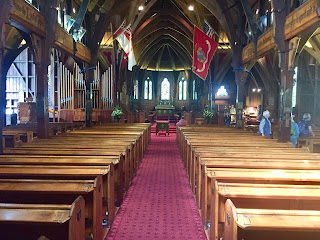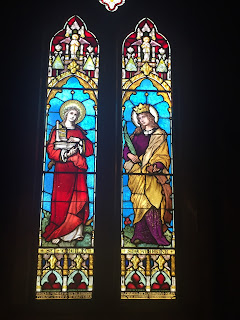 |
| This is a city park on the waterfront |
Wellington, the capital city of New Zealand, is also the second largest with a population of about 400,000. Built at the edge of the harbor its hills bring a resemblance to San Francisco, but this would be San Francisco on steroids. The Central Business District (CBD) is confined to a small area on the waterfront. Beyond that and the area around the airport, other than a narrow beachfront, the land rises quickly and steeply. Houses are built on the sides of those hills and the relatively few flat spots at their tops. One public tram and some escalators assist in the climb up some hills, but with ten different hills, this doesn’t solve the problem for everyone. Several homeowners have built private tramways or cable cars so they can reach their homes more easily than climbing stairs. Moving companies are said to charge as much as $50 per stair step when hired to move furniture. One upshot of the hills is that you see very few overweight people around town.


We made several other stops as part of the tour. One of these was at the rose garden. While only a couple of bushes were in bloom, it was easy to see how spectacular this will look before much longer.
 |
Wood for this lecturn from Wells Cathedral in England.
Everything else is local including the matching one opposite. |
We also spent some time at St. John’s Catholic Cathedral. Built in 1861 in a gothic style, but of local wood, it is a spectacular building on the inside. The natural reddish hue of the wood creates a beauty that is much different from the stone of European cathedrals. It is no longer used for services, but is available for religious events, weddings, and funerals. You just have to provide your own minister. This ranks among the best venues available for a wedding anywhere.



After winding around the beachfront, we ascended Mt. Victoria to the lookout atop that hill for another bird’s-eye view of the city. Our trip down from Mt. Victoria reminded us of our bus ride in the Norwegian fjords. The winding road was barely wide enough for two cars, yet people are allowed to park along the curb. This necessitates slow travel, pull-outs, and even the ability to back up on occasion if the two vehicles are to pass and continue on their way. Like in Norway, it appears that buses do NOT back up for cars.
 |
| Maori-inspired sculpture on a walkway on the waterfront |
 |
| A diving platform at the docks |
 |
| It's fake grass, but still very busy |
This is a city we could live in. It has been rated the world's most livable city. The vibrant night life includes good restaurants and plenty of music and theater venues. The redeveloping waterfront is a great place to hang out on a sunny day. Houses with a view are within walking distance of the city center or if you want to live further out, the bus system will get you there in minutes. Outdoor living is right on the doorstep whether you want to enjoy the water or the mountains. The train station, the airport, and the ferry landing are all within minutes of downtown. It reminds us a lot of home. Big enough to have all the amenities, small enough to feel comfortable. The only downside of living here is the strong winds that blow much of the season. Airline pilots need a special tick on their license to fly into the wind and the locals laugh at tourists trying to use an umbrella when it is raining, knowing the rubbish bins will be full of them tomorrow. Still, a little wind and rain is a small price to pay for everything else this city has to offer.
 |
It's hard to tell from this snapshot, but
the tower is built at an 18 degree slant
to emulate the strong winds |



















No comments:
Post a Comment